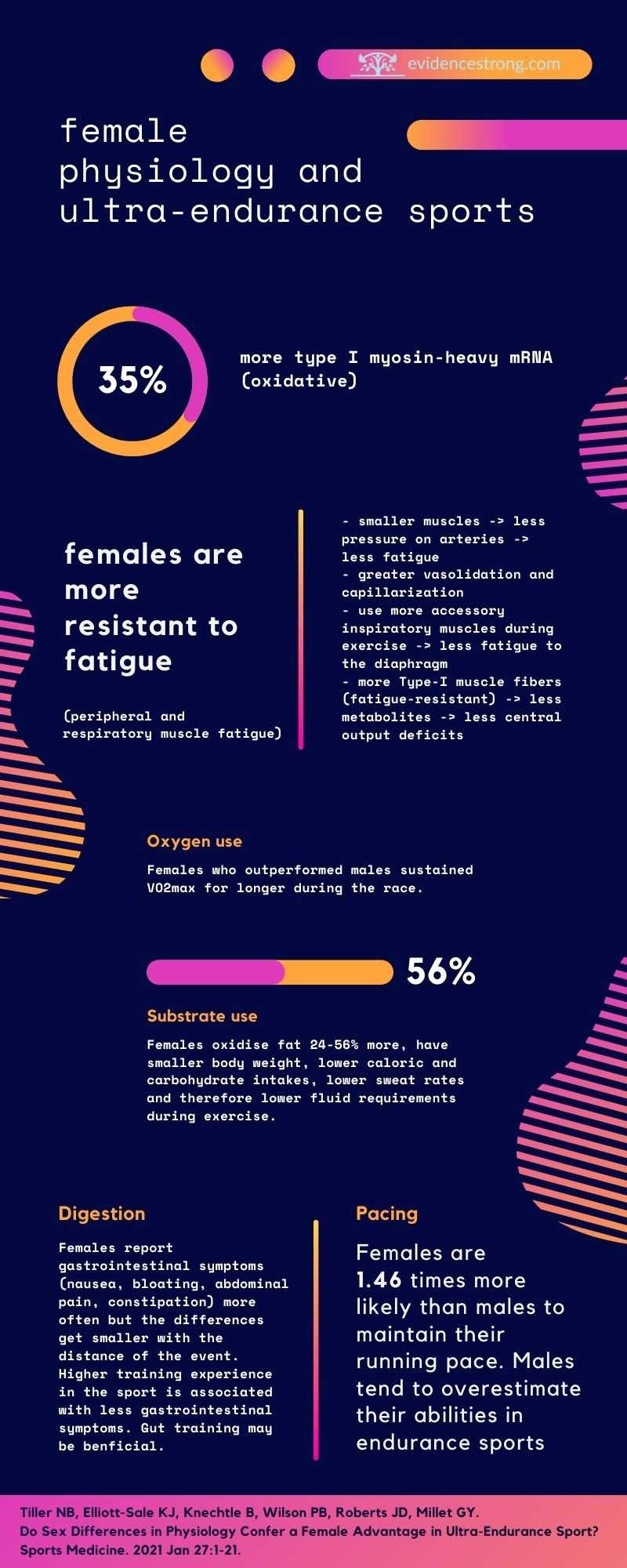Summary of a review analysing how female ultra-endurance athletes differ from male ultra-endurance athletes and possibly why.
Who
Female ultra-endurance athletes vs male ultra-endurance athletes.
Design
Review.
Outcome measures
- sex differences in muscle morphology, fatigability, substrate utilization, oxygen utilization, endocrine function, gastrointestinal distress
sex – "biological constituent which comprises the genetic complement of chromosomes, including cellular and molecural differences"
Main results
muscle fatigue: females are more resistant to fatigue (especially at suboptimal intensity) than males. Females experienced lower peripheral fatigue than male after 110km ultra-marathon, but central fatigue did not differ.
muscle morphology:
- females have more (44% via lower limb biopsy area) Type-I muscle fibers (fatigue-resistant) than males (36% via lower limb biopsy area). Higher proportion of type-I fibers in females is associated with greater vasodilatory capacity and capillarization.
- female have ~35% more type-I MYH (myosin-heavy) mRNA (oxidative), males have more type-II MYH mRNA (glycolytic). More type-I muscle fibres produce less metabolites during sustained submaximal exercise and therefore less central motor output deficits in females.
- muscle mass difference between females and males comes from difference in fiber diameter rather than number of fibers. Bigger muscles create higher pressure on arteries restricting blood flow and causing fatigue.
- expression of over 3000 genes is different in male skeletal muscles versus female skeletal muscles.
- no conclusive data on repeated eccentric contractions in lower limb extensors (used for long downhill running) and differences between male and female.
respiratory muscles: females are more fatigue resistant in respiratory muscles. Fameles’ inspiratory muscles fatigue slower. Famales’ diaphram fatigues slower as females rely on accessory inspiratory muscles more during dynamic exercise. Females’ respiratory muscles utilize greater relative percentage of VO₂.
pacing: females are 1.46 times more likely than males to maintain their running pace in marathon, and started 100km ultra-marathon with slower speed but finished with higher speed than males. Males tend to overestimate their abilities in endurance sports, have greater proclivity for risk-taking (associated with testosterone concentration)
substrate utilization: females have greater mRNA expression of genes for fats’ metabolism, higher estrogen-mediated reserves of intramyocellular lipids and bigger percentage of this lipids in contact with mitochondria after the exercise. Females oxidise fat 24-56% more than males over a 24-hour period (regardless of exercise). Females have lower caloric and carbohydrate intakes than males during ultra-endurance events. Females have smaller body weight, lower sweat rates and therefore lower fluid requirements during exercise.
oxygen utilization: females have lover VO₂max than males. VO₂max is the strongest predictor (56% of variance) of finish time in marathon. In 90km ultra-marathon females who outperformed males sustained VO₂max for longer during the race. Data on sex differences for running economy (oxygen economy) are inconclusive. (runners may compomise running economy to reduce muscle damage and peripheral fatigue).
endocrine function: higher testosterone concentration may influence hemoglobin concentration, mitochondrial function, lipid metabolism, and muscle protein synthesis (recovery) and favour males. Testosterone concentration did not affect muscle fatigability. Estrogen increases muscle size, strength, collagen content, bone mineral density, possibly enhances lipid oxidation, but also reduces tendon and ligament stiffness. (context: tendon stiffness correlates positively with running economy; anterior knee laxity changes with the menstrual cycle, knee is the most injured in ultra-endurance athletes)
gastrointestinal distress: on average female’s stomach is ~10% smaller than male’s. Food transit times are longer and gastric emptying is decreased in females. Gut permeabiliy was higher in males than females. Females report gastrointestinal symptoms more often (e.g., nausea, bloating, abdominal pain, constipation) but the differences get smaller with the distance of the event. Higher training experience in sport was associated with less gastrointestinal symptoms. Gut trainig may be benficial, especially for females. Females have lower requirements on food and fluid intake during the race, which could reduce the impact of higher susceptibility to gastrointestinal distress.
some other asspects possibly affecting ultra-endurance running: thermoregulation, sleep deprivation, contraception, nutrition and training regimens, race environment and terrain, psychology (motivation, competitiveness, risk taking).
Take home message
Original article
Tiller NB, Elliott-Sale KJ, Knechtle B, Wilson PB, Roberts JD, Millet GY. Do Sex Differences in Physiology Confer a Female Advantage in Ultra-Endurance Sport?. Sports Medicine. 2021 Jan 27:1-21.
